Sick and tired of the fancy and complicated fish tanks that need to be watched all the time? Are you ready for a stunning reef environment that can develop on its own from start to finish? That’s why a biotope aquarium is the best solution! Learn here how to design and set up a low-maintenance biotope aquarium, and you will find out how to establish a gorgeous and ecologically friendly underwater environment.
Content Table
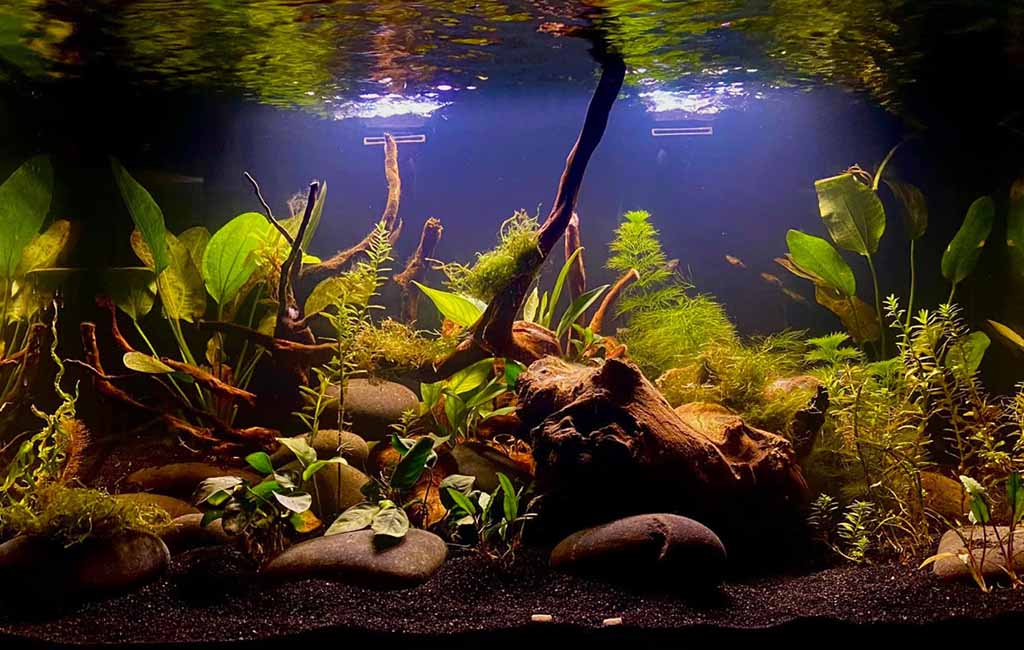
Low-maintenance biotope aquarium
Before Building a Low-Maintenance Biotope Aquarium
Formation of a low biotope aquarium is indeed one of the methods of implanting a particular ecosystem in your home, with much attention on fish tank care. Here’s a checklist of essentials you need to prepare:
Tank
- Select a size that will contain a fish and plant type you want to put in an aquarium. A 20-gallon tank is optimum for most biotopes when one starts or has limited space.
- Place the tank on a strong and flat surface to avoid all kinds of complications related to support.
Lighting
- Choose a lighting regime appropriate to the plants and fishes that are to be accommodated in your biotope tank. Thus, LED lights are energy-saving, and their global usage can be controlled.
- Light conditions also have to correspond to the natural environment that imitates (for example, low light for riverbeds and high for shallow streams).
Background Paper
Choose a background that blends with the biotope, or use a plain black or blue sheet of paper or even a picture of the habitat. A background contributes to the visual appeal of the unit and offers the fish a less stressful environment as it goes around the back of the tank.
Filter
- Choose a fish tank filter that suits the biotope’s water flow requirements:
| Slow-flow filters for swamp or marsh biotopes | High-flow filters for river or stream biotopes |
- Consider sponge filters or external canister filters for easy maintenance.
Aquascape
- Use substrate, driftwood, rocks, and plants that mimic the chosen habitat:
| Substrate: Sand or gravel that aligns with the biotope | Driftwood and Rocks: For structure and hiding spots. Ensure they’re aquarium-safe | Plants: Native to the biotope, such as Java moss for Southeast Asian habitats or Amazon swords for South American ones |
Water Parameters
- Invest in a water testing kit to ensure pH, hardness, and temperature match the biotope.
- Use a water conditioner to neutralize chlorine and heavy metals.
Heater (If Necessary)
- For tropical biotopes, choose a reliable heater to maintain consistent water temperature.
- A thermometer helps monitor conditions.
Fish and Invertebrates
- Select species that naturally coexist in your chosen biotope.
- Research their specific requirements to ensure compatibility and ease of care.
Low-Maintenance Plants
- Opt for slow-growing, hardy plants like Anubias, Java fern, or Cryptocoryne that require minimal pruning and maintenance.
Optional Extras
- Air Pump: Adds oxygenation, especially in tanks with high fish populations.
- Leaf Litter: Mimics forest floors in certain biotopes and promotes natural behavior.
- Aquarium Lid: Prevents evaporation and jumping fish.
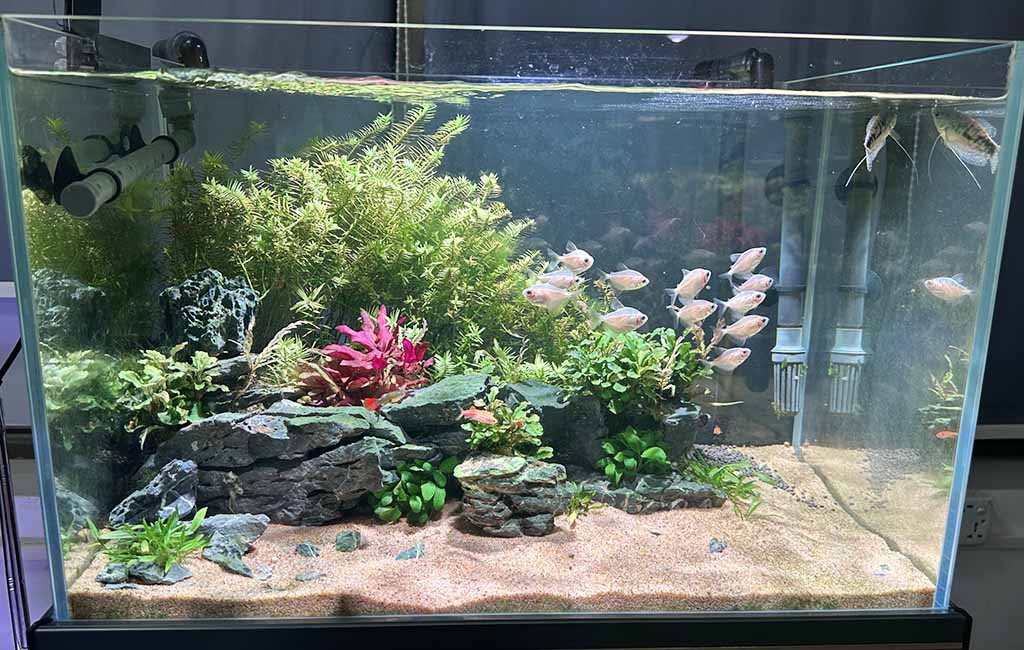
Simple biotope aquarium
The Role of Fish Tank Background Paper
The fish tank background paper makes the overall look of the aquarium, as it improves on the scenery through the provision of an appealing backdrop to the aquascape of the tanks. Some of the benefits it has are;
- They minimize distractions because they hide things like wires and filters, giving an all-natural appearance.
- Besides, it also has low stress on fish through creating an environment that is natural for them and also no reflections off the glass.
- The background paper is an inexpensive and simple way to change a tank’s look while improving conditions for the inhabitants.
Create an Ecological Substrate and Sand
Designing the right substrate for your biotope aquarium ensures healthy plant growth, water quality, and natural aesthetics. Here’s how to choose and layer the ideal substrate.
Why Use Ecological Substrate?
- Nutrient Source: Ecological substrates like fertilizer-enriched soil, pumice, and humus provide essential nutrients for plant growth.
- Mimics Natural Environments: These materials replicate the natural ecosystem, supporting beneficial bacteria that stabilize water chemistry.
- Low Maintenance: Properly selected ecological substrates require minimal upkeep, as they establish a self-sustaining nutrient cycle over time.
- Improves Biotope Functionality: They enhance plant rooting, reduce algae growth, and promote healthy aquatic ecosystems.
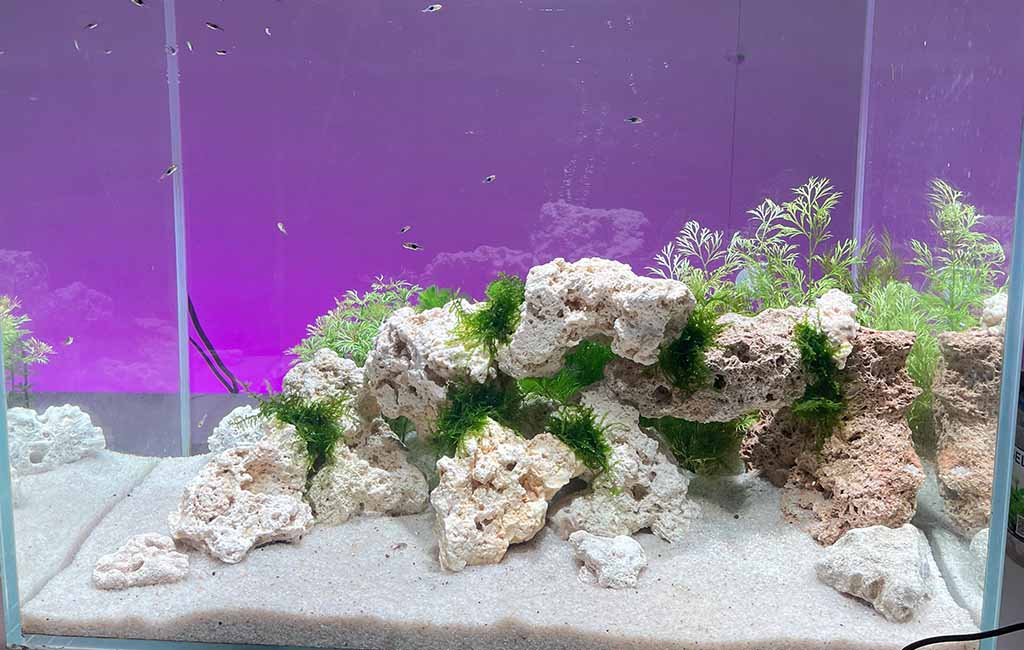
Create a Low-Maintenance Biotope Aquarium
Components of an Ecological Substrate
- Base Layer (Nutrient-Rich):
Fertilizer Soil: Organic soils or aquarium-specific substrates rich in macronutrients for plants.
Humus: Boosts organic content and improves water retention.
Old Substrate: Reusing aged substrate introduces established beneficial bacteria. - Middle Layer (Aeration):
Pumice or Lava Rock: Improves aeration, prevents compacting, and encourages microbial growth. - Top Layer (Protective):
Fine Sand or Gravel: Prevents nutrient leaching and keeps the base layer intact.
Choosing the Sand
- Type: Use natural-colored fine sand to create a realistic and visually appealing environment.
- Benefits: Sand supports bottom-dwelling species, allows plant roots to penetrate, and beautifies the aquarium.
- Height and Space:
| Ensure the total substrate height is 2–3 inches for proper plant rooting |
| Add sand as the top layer (1 inch thick) to secure underlying materials |
| Leave open sandy areas for fish that sift or dig in the substrate |
Aquascape Wood or Rocks
Substrates, especially driftwood, and rocks, are important for use in aquascape designs both for the appearance of the aquarium and the well-being of the fish. Aquatic plants such as driftwood promote the growth of natural shapes, include discharge-free tannin, and offer cocoons to fish. Rocks improve structural design, support plant location, and simulate rivers or any natural habitats that involve rock surfaces.
Before buying the materials, ensure you use those that are safe for use in the aquarium and that can harmonize with the biotope in the water. Using the woods and stones together for the decoration of the aquarium will help to create an amazing and balanced aesthetic look of the underwater world.
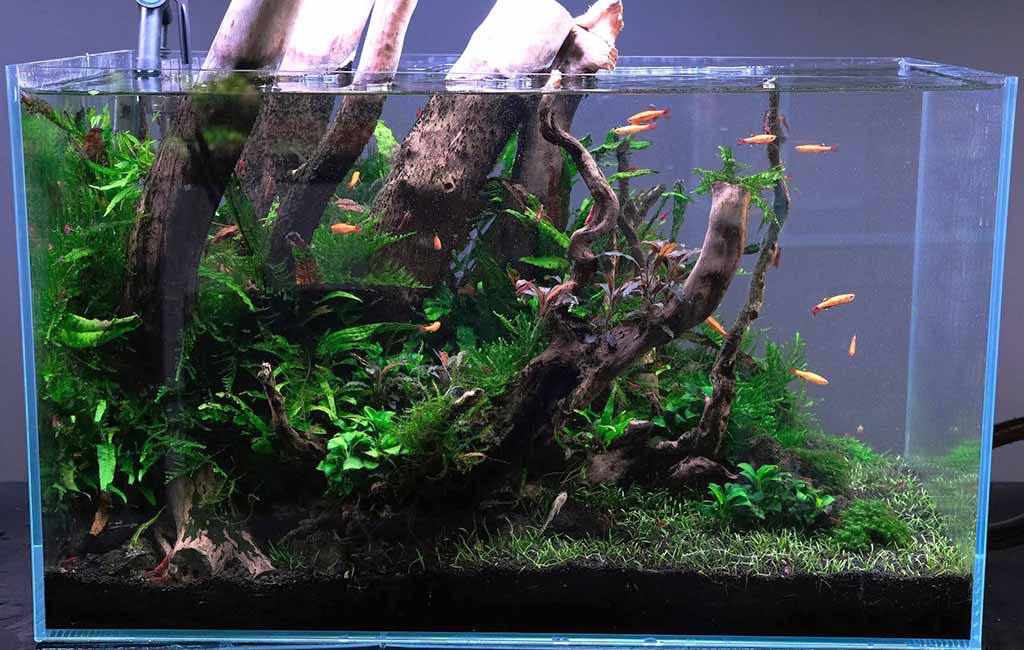
Biotope Aquarium Wood
Low Carbon Dioxide Plants
Selecting low-carbon dioxide (CO2) plants is ideal for a low-maintenance biotope aquarium. These plants thrive without supplemental CO2 and adapt well to natural water conditions. Some excellent choices include:
- Anubias– Hardy, slow-growing plants that can attach to driftwood or rocks.
- Java Fern– Resilient and adaptable, perfect for shaded areas.
- Cryptocoryne– Diverse species that thrive in low light and nutrient-rich substrates.
- Vallisneria– Great for creating tall, flowing greenery in the background.
- Amazon Sword– A classic biotope choice for larger tanks.
These plants maintain water quality, enhance aesthetics, and provide shelter for aquatic life.
When to Introduce the Aquatic Pet
Introducing aquatic pets like fish, shrimp, or snails to your tank requires careful timing and a gradual process to ensure their health.
When: Only add aquatic pets after the tank has completed its nitrogen cycle, which typically takes 4–6 weeks. The water should be free of ammonia and nitrites, with minimal nitrates.
How to Introduce Them to the Tank
- Acclimation: Float the pet’s bag in the tank for 15–20 minutes to equalize the temperature.
- Water Mixing: Gradually mix tank water into the bag over 30–60 minutes to acclimate to water chemistry.
- Release: Gently net the pet and place it in the tank to avoid transferring bag water.
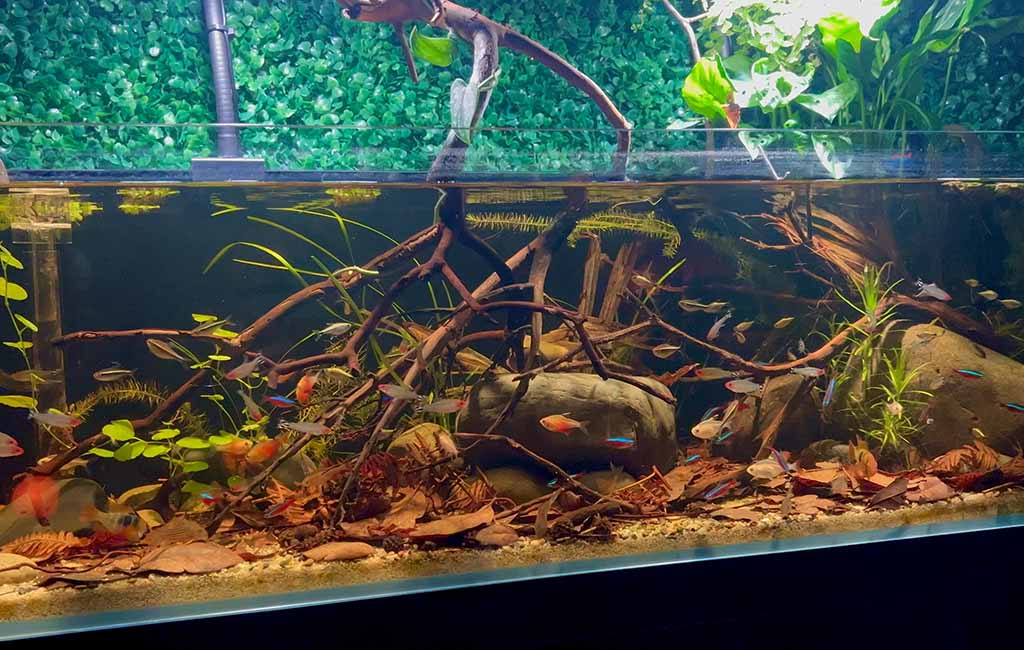
Low-maintenance aquarium pet
What To Do After Building Biotope Aquarium
After setting up your biotope aquarium, follow these steps to ensure a healthy and thriving environment:
- Cycle the Tank: Let the aquarium go through the nitrogen cycle (four to six weeks) to foster good bacterial growth. This makes sure that the tank can cope with the wastes it produces without dangerous ammonia or nitrites.
- Test Water Parameters: Ideally check on pH, hardness, ammonia, nitrites, and nitrates to maintain the water conditions of the fish’s natural habitat.
- Introduce Aquatic Pets Gradually: These should be introduced later after the tank has cycled though, the fish type that should be introduced while cycling is not the one needed to complete the aquarium community. Use the tough species at the beginning and overcrowding should be avoided.
- Monitor Aquascape Growth: See how it grows and develops over a space of time depending on the plant’s type, and adapt the decor to fit the environment.
- Regular Maintenance: Weekly to biweekly partial water changes should be done at 10-20%. Scrub the filter; look for algae; remove dead plant matter or debris.
- Observe Fish Behavior: Observe how the aquatic life changes as a response to the environment. Make sure to have no stress or illness signs detected.
Leaving a Lasting Impression
Setting up a biotope aquarium is easy, and you get to enjoy a nature-inspired aquarium with minimal full-time care. It is therefore possible to mimic this natural world through the right type of tank, substrate, plants, and fish so that the system does not need much management intervention. If set properly and with the correct combinations, you’re sure to have a thriving and stunning biotope in your home. These few basic measures will ensure you have a good start to a long-lasting aquarium where nature’s balance has been replicated.
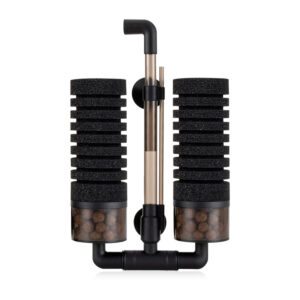
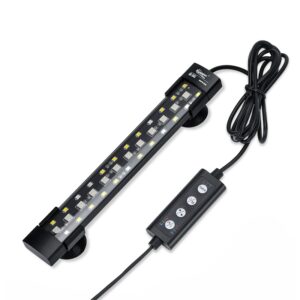
Leave a comment